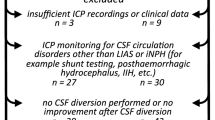Abstract
Much has been written about the relationship between the pulse pressure (PP) of the intracranial pressure pulse wave (ICPPW) and ventricle dilatation. Some data suggest that high PP is the cause of ventricle dilatation, and other authors have reported that high PP results from decreased intracranial compliance. In order to clarify these points, the amplitude of PP and pressure-volume response (PVR: an indicator of intracranial complicance) were measured in bilateral ventricles using Hochwald's hydrocephalic model (right-left difference in ventricle size is clear due to hemicraniectomy). Hydrocephalus was induced by means of intracisternal injection of a kaolin powder solution to dogs. The mean ICP, amplitude of the PP, PVR and ventricle size (estimated by MR imaging) were evaluated in pathologic conditions induced by the following procedures. Group A, control: kaolin-induced hydrocephalus without craniectomy; group B: kaolin-induced hydrocephalus with right-sided craniectomy; group C: kaolin-induced hydrocephalus with right-sided craniectomy and dural resection; group D: kaolin-induced hydrocephalus with right-sided craniectomy, dura resection and temporal muscle resection. Using MR imaging, the same degree of symmetrical ventricle dilatation was identified in all groups except group D. Group D alone demonstrated a difference in ventricular size (craniectomy side > non-craniectomy side). There was no appreciable difference in mean ICP between any two groups. However, the amplitude of PP and the PVR decreased stepwise from group A to group D. The difference in the amplitude of the PP and PVR between the right and left ventricles was not significant in any group. Even on the larger ventricle side (right) in group D, the amplitude of PP was the same as that of the left ventricle, and much smaller than in other groups. The results of our research suggest that: (1) There was no relation between ventricle dilatation and the amplitude of PP. This means that the increased amplitude of PP was not the cause of the ventricle dilatation in this model. (2) A high degree of correlation exists between the amplitude of PP and the PVR. This means that PP can be a good parameter of intracranial compliance in this model
Similar content being viewed by others
References
Bering EA (1955) Choroid plexus and arterial pulsation of cerebrospinal fluid. AMA Arch Neurol Psychiatry 73:165–172
Conner ES, Foley BS, Black PM (1984) Experimental normal pressure hydrocephalus is accompanied by increased transmantle pressure. J Neurosurg 61:322–327
Di Rocco C, Pettorossi VE, Caldarelli R, et al (1977) Experimental hydrocephalus following mechanical increment of intraventricular pulse pressure. Expcrimentia 33:1470–1472
Di Rocco C, Pettorossi VE, Caldarelli R, et al (1978) Communicating hydrocephalus induced by mechanically increased amplitude of the intraventricular cerebrospinal fluid pressure. Exp Neurol 59:40–52
Epstein CM (1974) The distribution of intracranial forces in acute and chronic hydrocephalus. J Neurol Sci 21:171–180
Fishman RA, Green M (1963) Experimental obstructive hydrocephalus. Arch Neurol 8:156–161
Hochwald GM, Epstein F, Malahan C (1972) The role of the skull and dura in experimental feline hydrocephalus. Dev Med Child Neurol 14 [Suppl 27]:65–69
Matsumoto T, Nagai H, Kasuga K, Kamiya K (1986) Changes in intracranial pressure (ICP) pulse wave following hydrocephalus. Acta Neurochir 82:50–56
Nagai H, Kamiya K, Ohno M (1983) Importance of the pulse amplitude in ventriculomegaly. In: Ishii S (ed) Hydrocephalus. Excerpta Medica, Amsterdam, pp 126–134
Rekate HL, Brodkey JA, Chizeck HJ (1988) Ventricular volume regulation: a mathematical model and computer simulation. Pediatr Neurosci 14:77–84
Rekate HL, Williams FC, Broadkey JA (1988) Resistance of the foramen of Monro. Pediatr Neurosci 14:85–89
Author information
Authors and Affiliations
Rights and permissions
About this article
Cite this article
Matsumoto, T., Nagai, H., Fukushima, T. et al. Analysis of intracranial pressure pulse wave in experimental hydrocephalus. Child's Nerv Syst 10, 91–95 (1994). https://doi.org/10.1007/BF00302770
Issue Date:
DOI: https://doi.org/10.1007/BF00302770




